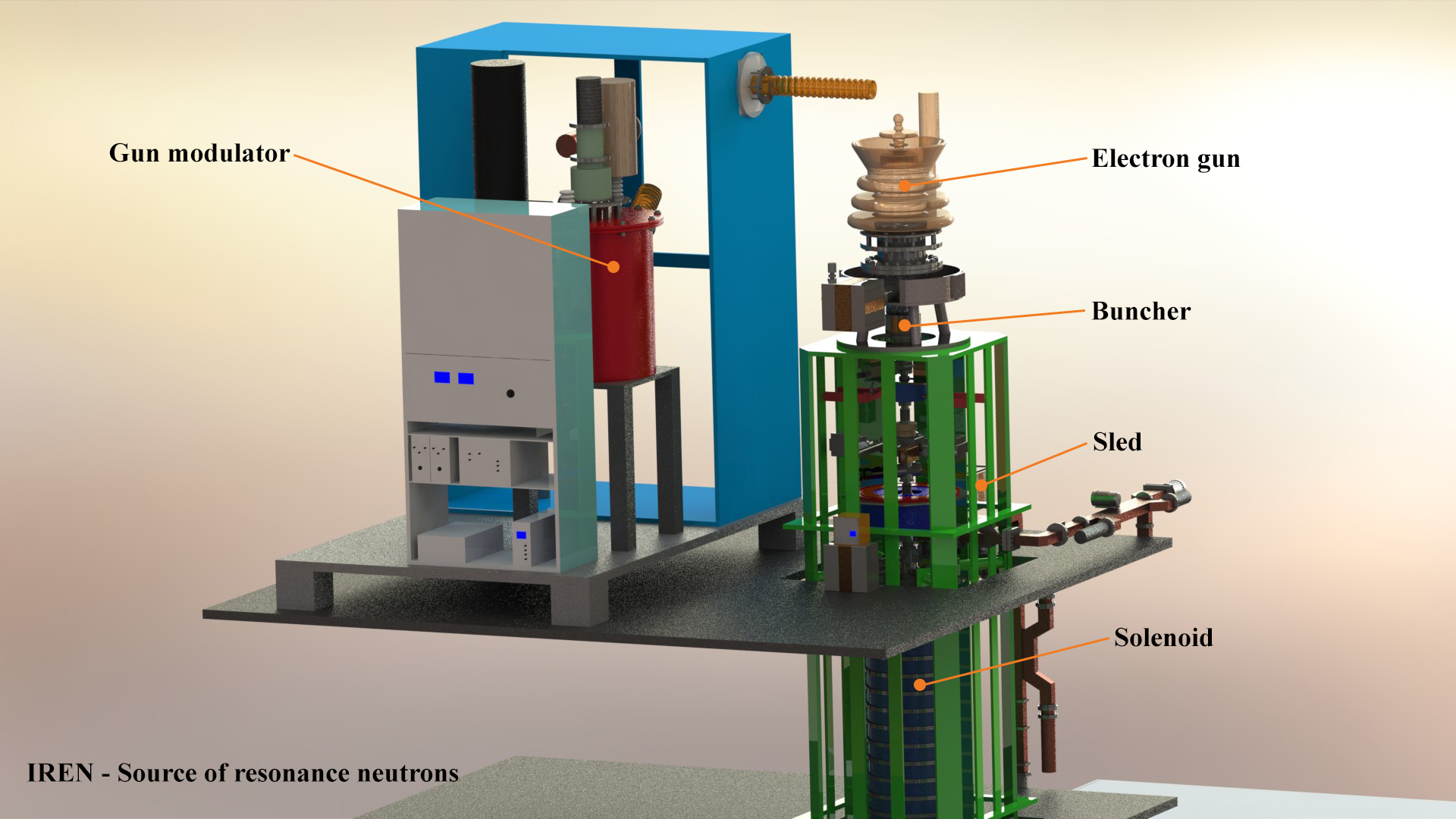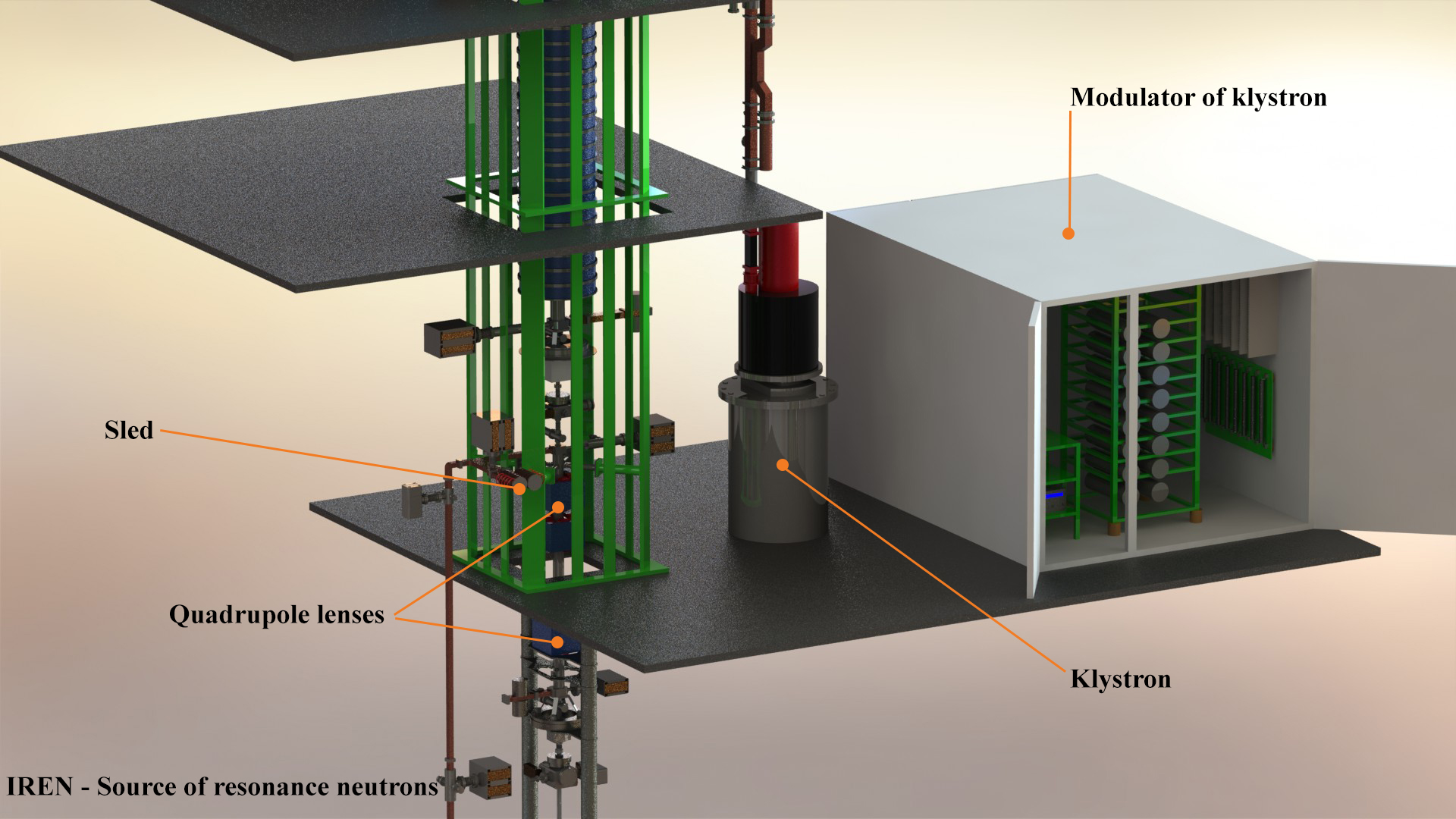Responsible for the facility
Golubkov Evgeny
Тел. +7 (496) 216-35-84
e-mail: This email address is being protected from spambots. You need JavaScript enabled to view it.
Main research areas
1. Investigation of time reversal invariance violation with polarized resonance neutrons and a polarized target
2. Investigation of parity violation in reactions with neutrons (fission, (n,a), (n,p), (n,g))
3. Electromagnetic structure of the neutron
4. Quantum aspects of neutron-induced fission
5. Phase transitions in excited nuclei - chaos and ordering in quantum systems
6. Nuclear data for astrophysics
7.Nuclear data for applied research
8. Isotopic analysis with resonance neutrons
Description of IREN
The linear electron accelerator LUE-200 was designed at the Budker Institute of Nuclear Physics of Siberian branch of RAS (Novosibirsk) as a driver for the intense resonance neutron source IREN. The accelerator consists of a pulsed electron gun, an accelerating system, microwave power sources based on 10-cm klystrons with modulators, a focusing-beam transport system, a diagnostics system with a broadband magnetic spectrometer and a vacuum system. The accelerator is positioned vertically in a three-storey building of the former IBR-30 facility of the Frank Laboratory of Neutron Physics of JINR.
General schematic of the IREN facility (Intense Resonance Neutron Source) Accelerator and target halls.
EG - electron gun;
ML1, ML2, ML3 - short solenoidal magnetic lenses;
GS - short grouper solenoid;
S1 - focusing solenoid of the first accelerating section;
CIE, CS1, CS2, C3, C4, C5 - corrective magnets;
Q1 - the first quadrupole lens;
Q2-Q3, Q4-Q5 - doublets of wide-aperture quadrupole lenses;
Q6-Q7, Q8-Q9 - doublets of quadrupole lenses;
MB - microwave buncher;
AS1 - the first accelerating section;
AS2 - the second accelerating section;
MS - magnetic spectrometer;
T - target - converter;
BV1, BV2, BV3, BV4, BV5 – beamviewers;
RC1, RC2, RC3, RC4, RC5 - magnetoinductive beam current sensors (Rogowski coils).
The accelerating section, klystron and modulator are installed with the development of the accelerator. The first stage provides for the operation of a neutron source based on a non-breeding neutron-producing target.
Electron gun
Accelerator Hall. (room 308, building 43).
Electron gun; Gun modulator; Buncher; Accelerator section.
A 2-electrode electron gun with an oxide thermal cathode of Ø 12 mm from a GS-34 microwave lamp is used as an electron source in the accelerator. The electron gun provides a pulsed beam current up to 6 A with a pulse duration of 250 ÷ 300 ns with a cycle frequency of 50 Hz and an emittance of ≤ 0.01 π·cm·mrad.
Accelerating system
Accelerator Hall. (room 308, building 43).
Modulator of the first klystron; Klystron (Toshiba E37340); Quadrupole lenses; 2nd Accelerator section; SLED
The accelerating system consists of a microwave grouper and two short (with a length of 3 meters each) accelerating sections with an extremely high acceleration rate. The accelerating sections have been designed and manufactured at BINP SB RAS. An accelerating section is a circular diaphragm waveguide with constant impedance fed by microwave power. The sections are powered using klystrons - microwave amplifiers with a frequency range of 10 cm (2856 MHz). The prototype of the accelerating system was tested on the foreinjector of the VEPP-5 complex at BINP, where the maximum accelerating field of 45 MV/m and the average accelerating rate of 35 MeV/m [4, 5] were achieved. The design of the accelerator provides for the assembly of two sections 3 m long for the design energy of electrons. As part of the first stage of the accelerator, one accelerating section has been mounted. Instead of the second accelerating section, a drift section with two quadrupole doublets has been installed.
Measurement of the energy and energy spectra of the beam
Accelerator Hall. (room 218, building 43).
Klystron modulator; Klystron (Thompson TH2129); Magnetic spectrometer; quadrupole lenses.
To measure the spectra of the electron beam energy, a broadband magnetostatic analyzer with a magnetic field transverse towards the motion of the beam particles is used. The magnet of the W-shaped spectrometer with a magnetic rigidity varying within 0.166 – 0.7 T m is positioned in the gap between the designed second accelerating section and the doublet of Q6 – Q7 quadrupole lenses. The electron beam in the magnetic field of the spectrometer is rotated through an angle close to 90°, through a window closed with foil (50 μm, stainless steel) is removed from the vacuum chamber into the atmosphere to the position-sensitive total absorption beam collector. Collector lamella signals are measured in one cycle and processed in offline mode. The design features of the magnetic analyzer allow to measure energy spectra with a relative accuracy of ΔE/E no worse than ± 5%.
Non-breeding and neutron-producing target
Target Hall. (room 128, building 43).
Target; Neutron guide valves.
An alloy based on tungsten TNF-90 was selected as a material for the neutron-producing non-breeding target. Neutrons in the target are produced as a result of a two-step process. First, the accelerated electrons stop in the target, occurring braking quanta. The energy spectrum of gamma quanta is limited from above by the maximum energy of accelerated electrons. Then, as a result of the interaction of high-energy gamma quanta with the nuclei of tungsten isotopes, neutrons are produced in the reactions AW(γ, n)A-1W. The target is a TNF cylinder with a diameter of 40 mm and a height of 100 mm, positioned inside an aluminum tank with a diameter of 160 mm, through which distilled water is circulated from a closed circuit to cool the target and produce the neutron spectrum. The radial thickness of the water layer is 50 mm. The accelerated electrons pass inside the tank through a hemispherical beryllium window 36 mm in diameter and 1 mm thick. A thermocouple is installed at the front end of the target for on-line control of the target temperature.
Basic parameters Maximum emission current (A) 4.2 Repetition rate (Hz) 50 Electronic pulse duration (ns) 100 Electron energy (MeV) 115 Beam power (kW) 1 Neutron yield (n/s) 2·1012
Virtual excursion to the IREN facility




